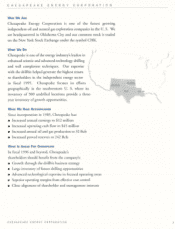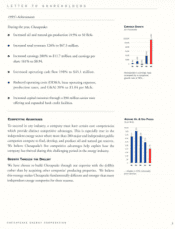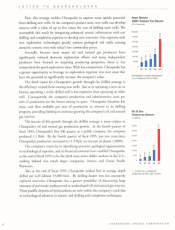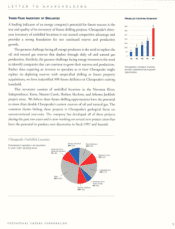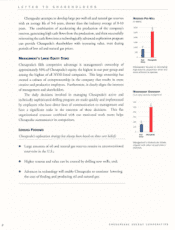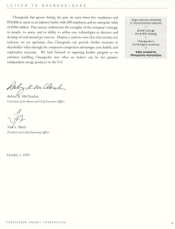Chesapeake Energy 1995 Annual Report Download - page 8
Download and view the complete annual report
Please find page 8 of the 1995 Chesapeake Energy annual report below. You can navigate through the pages in the report by either clicking on the pages listed below, or by using the keyword search tool below to find specific information within the annual report.
LETTER TO SHAREHOLDERS
TECHNOLOGICAL LEADERSHIP
The increasing rate of technological change in such areas as horizontal drilling,
3-dimensional seismic, and deep fracture stimulation have enabled technically
sophisticated companies such as Chesapeake to identify and develop new oil
and natural gas reserves more profitably than at any time during the past 20
years. Although Chesapeake has distinguished itself in each of these new
technologies, Chesapeake's leadership in horizontal drilling is particularly
important. During fiscal 1995, Chesapeake drilled 61 horizontal wells and
has drilled 230 horizontal wells since 1990. The company's expertise in
horizontal drilling provides lower costs per foot of horizontal wellbore drilled
and the potential for recovery of more reserves per dollar invested, both of
which result in lower finding costs and higher operating margins.
The talent of Chesapeake's landmen, geologists, and engineers, the
company's strong relationships with the vendors who design and manufacture
horizontal equipment, and our willingness to experiment with new ideas have
enabled Chesapeake to drill increasingly deeper horizontal wells and thereby
expand the boundaries of our fields. For example, in just the past year,
significant improvements in measurement-while-drilling and logging-while-
drilling tools, downhole motors, and drilibit technology have contributed to
Chesapeake's extension of the downdip limit in Giddings from 13,000 feet to
almost 15,000 feet.
The continued extension of this limit is important because as horizontal
drilling technology improves, the number of prospective drilisites on
Chesapeake's 350,000 gross acre leasehold inventory in Texas and Louisiana
continues to increase. Specifically, for every 1,000 feet deeper the company
can drill, up to 50 additional drilisites become prospective. Chesapeake's
deeper drilling expertise should also enable the company to extend its
downdip Giddings success into the potentially prolific Leesville and Masters
Creek areas of Louisiana.
Chesapeake has also helped advance the technology of drilling multiple
horizontal laterals from a single vertical welibore. Drilling two or more
horizontal laterals enables Chesapeake to develop its reserves by drilling fewer
wells and thereby more efficiently using the company's capital. In the
Independence area of the Giddings Field, Chesapeake is drilling its first
quadrilateral well. This well has been designed to simultaneously produce
reserves from both the Austin Chalk and Georgetown formations by drilling
four horizontal laterals from one vertical welibore. We anticipate a cost savings
of 50% compared to drilling four single lateral horizontal wells.
HORIZONTAL WELLS DRILLED
(cumulative wells)
250
200
150
Austin Chalk
Georgetown Buda
91. 92 93 94 95 1Q96
Chesapeake is the second most
active driller of horizontal wells in
the U.S.
HORIZONTAL DRILLING EXPERTISE
chesapeake is now able to drill tour
laterals from one vertical wellbore.
Austin Chalk
6CHESAPEAKE ENERGY CORPORATION



